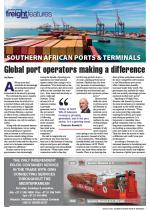The southern African ports sector is booming – and developments in both the western and eastern regions of the continent are evidence of this.Countries have realised that ports are a vital cog in the supply chain, and essential not only for trade internationally but also to grow the much-talked-about inter-regional trade to which Africa is aspiring under the African Free Trade Area (AfCFTA).“Realising growth ambitions requires countries to take advantage of the economic potential of its ports and shipping sector, and a lot is happening in this regard,” said Duncan Bonnett, a partner at Africa House. “There are several exciting developments at present that we are watching closely. First and foremost are the developments at the Port of Banana in the Democratic Republic of the Congo.”Port of Banana This small seaport is situated in Banana Creek along the country’s 37km coastline on the Atlantic Ocean in Kongo Central province. Essentially, a wharf of 75m with a depth of 5.18m and a few small jetties serviced by a crane or two is being transformed by DP World into a modern world-class port that will undoubtedly be a game changer for the DRC.“They are putting in a fair amount of resources in developing this deepwater port for the DRC, greatly enhancing the country’s access to international markets and global supply chains,” said Bonnett. “What makes this development even more exciting is that there are talks that this is exactly what was needed to unlock some of the Grand Inga projects.”With Australia’s Fortescue Metals Group (FMG) already on board with the Inga III hydropower project, the developments at the Port of Banana are being watched carefully. “Inga III cannot happen without the development of a port such as this,” explained Bonnett. “The Port of Matadi, currently the chief seaport of the DRC, is simply too small and the logistics would be a nightmare. The investments into Banana start to unlock real value for the DRC when it comes to Inga III.”Ongoing investments in the Angolan ports also herald improved logistics for southern African landlocked countries. The country currently has five seaports, with plans under way to introduce a sixth port some 50km north of Luanda. According to Bonnett, the Angolan government has been committed to signing agreements with private companies to boost the port and terminals sector. “DP World is entrenched in the country and is investing heavily in their operations here. More recently the government signed a 30-year concession with a consortium of Trafigura, Mota-Engil Engineering and Construction Africa, and Vecturis, Belgium, to operate rail services and offer logistical support for the Lobito corridor in particular.”Significant investment in Namibia expectedIn Namibia, more port investment can also be expected on the back of massive oil and gas finds, as well as green hydrogen developments. “We are expecting to see a lot of investment in the Namibian port sector in the next few years. Not only because of the oil and gas, but also because of developments such as the prospective iron ore mine in Botswana where feasibility studies are under way. All indications are that this ore will be exported via the Port of Walvis Bay, which will require a serious upgrade to the bulk terminal. Projects are for a minimum of five million tons of iron ore per year, ramping up to at least 20 to 30m tonnes per year.”Investment into the Port of Luderitz could also be expected considering its proximity to developments around green hydrogen, said Bonnett.Ramping up the east coastOngoing investment into Mozambique’s ports has seen the country significantly increase the volumes it has been handling in recent years. “It is also actively working towards growing volumes and improving the f low of trade, as we have seen with the move by DP World to open a dry port in Komatipoort,” said Bonnett.He highlighted that while volumes were still small compared to that of South African ports, the Port of Maputo, in particular, was gradually becoming a significant player in the southern African port sector. “We are seeing an increase in the volume of mining and agricultural commodities moving through this port as challenges with the South African ports continue. As the port starts to attract more direct sailings, there is no doubt it will increase its competitiveness even more.”He said the Port of Beira was another port on the eastern side that was going from strength to strength, attracting more trade from the likes of Zambia and the DRC. “The port has always done a lot of trade with Malawi and Zimbabwe, but the volumes from Zambia and the DRC are increasing.”He said in Mozambique the Port of Nacala was probably the only one struggling and that was more to do with getting the necessary volumes than anything else.“The adage of build it and the volumes will come is not necessarily true. Port development in southern Africa is very closely linked to the volumes. If one looks at the freight coming out of the DRC and Zambian Copperbelt, one is looking at around eight million tons of cargo. For a single port, this is good volume, but every port in the region is vying for the same eight million tons.”Even the Port of Dar es Salaam is increasingly exporting copper and cobalt from the DRC. “Ongoing investments in these ports are therefore dependent on how much volume they can attract. There is a lot of activity in the port sector and competition is increasing.”

